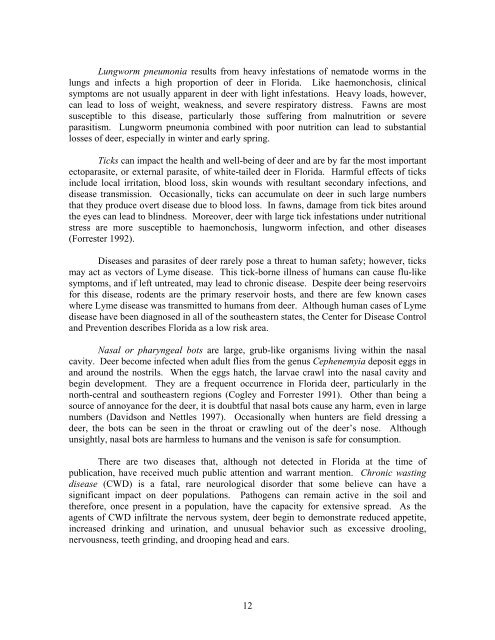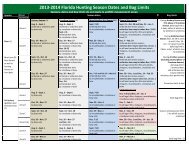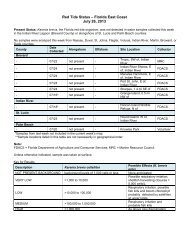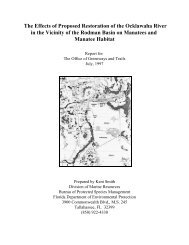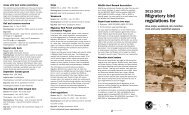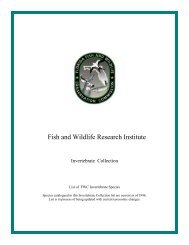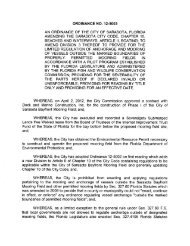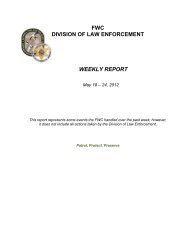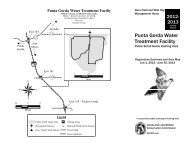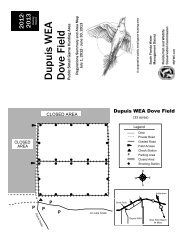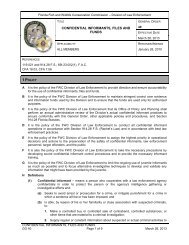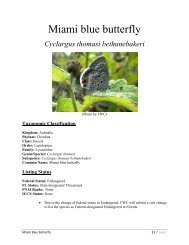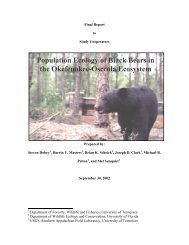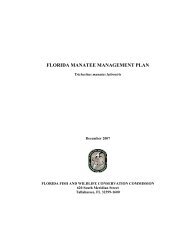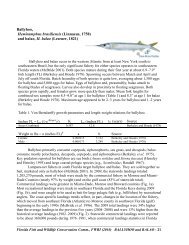Ecology and management of white-tailed deer in - Florida Fish and ...
Ecology and management of white-tailed deer in - Florida Fish and ...
Ecology and management of white-tailed deer in - Florida Fish and ...
You also want an ePaper? Increase the reach of your titles
YUMPU automatically turns print PDFs into web optimized ePapers that Google loves.
Lungworm pneumonia results from heavy <strong>in</strong>festations <strong>of</strong> nematode worms <strong>in</strong> the<br />
lungs <strong>and</strong> <strong>in</strong>fects a high proportion <strong>of</strong> <strong>deer</strong> <strong>in</strong> <strong>Florida</strong>. Like haemonchosis, cl<strong>in</strong>ical<br />
symptoms are not usually apparent <strong>in</strong> <strong>deer</strong> with light <strong>in</strong>festations. Heavy loads, however,<br />
can lead to loss <strong>of</strong> weight, weakness, <strong>and</strong> severe respiratory distress. Fawns are most<br />
susceptible to this disease, particularly those suffer<strong>in</strong>g from malnutrition or severe<br />
parasitism. Lungworm pneumonia comb<strong>in</strong>ed with poor nutrition can lead to substantial<br />
losses <strong>of</strong> <strong>deer</strong>, especially <strong>in</strong> w<strong>in</strong>ter <strong>and</strong> early spr<strong>in</strong>g.<br />
Ticks can impact the health <strong>and</strong> well-be<strong>in</strong>g <strong>of</strong> <strong>deer</strong> <strong>and</strong> are by far the most important<br />
ectoparasite, or external parasite, <strong>of</strong> <strong>white</strong>-<strong>tailed</strong> <strong>deer</strong> <strong>in</strong> <strong>Florida</strong>. Harmful effects <strong>of</strong> ticks<br />
<strong>in</strong>clude local irritation, blood loss, sk<strong>in</strong> wounds with resultant secondary <strong>in</strong>fections, <strong>and</strong><br />
disease transmission. Occasionally, ticks can accumulate on <strong>deer</strong> <strong>in</strong> such large numbers<br />
that they produce overt disease due to blood loss. In fawns, damage from tick bites around<br />
the eyes can lead to bl<strong>in</strong>dness. Moreover, <strong>deer</strong> with large tick <strong>in</strong>festations under nutritional<br />
stress are more susceptible to haemonchosis, lungworm <strong>in</strong>fection, <strong>and</strong> other diseases<br />
(Forrester 1992).<br />
Diseases <strong>and</strong> parasites <strong>of</strong> <strong>deer</strong> rarely pose a threat to human safety; however, ticks<br />
may act as vectors <strong>of</strong> Lyme disease. This tick-borne illness <strong>of</strong> humans can cause flu-like<br />
symptoms, <strong>and</strong> if left untreated, may lead to chronic disease. Despite <strong>deer</strong> be<strong>in</strong>g reservoirs<br />
for this disease, rodents are the primary reservoir hosts, <strong>and</strong> there are few known cases<br />
where Lyme disease was transmitted to humans from <strong>deer</strong>. Although human cases <strong>of</strong> Lyme<br />
disease have been diagnosed <strong>in</strong> all <strong>of</strong> the southeastern states, the Center for Disease Control<br />
<strong>and</strong> Prevention describes <strong>Florida</strong> as a low risk area.<br />
Nasal or pharyngeal bots are large, grub-like organisms liv<strong>in</strong>g with<strong>in</strong> the nasal<br />
cavity. Deer become <strong>in</strong>fected when adult flies from the genus Cephenemyia deposit eggs <strong>in</strong><br />
<strong>and</strong> around the nostrils. When the eggs hatch, the larvae crawl <strong>in</strong>to the nasal cavity <strong>and</strong><br />
beg<strong>in</strong> development. They are a frequent occurrence <strong>in</strong> <strong>Florida</strong> <strong>deer</strong>, particularly <strong>in</strong> the<br />
north-central <strong>and</strong> southeastern regions (Cogley <strong>and</strong> Forrester 1991). Other than be<strong>in</strong>g a<br />
source <strong>of</strong> annoyance for the <strong>deer</strong>, it is doubtful that nasal bots cause any harm, even <strong>in</strong> large<br />
numbers (Davidson <strong>and</strong> Nettles 1997). Occasionally when hunters are field dress<strong>in</strong>g a<br />
<strong>deer</strong>, the bots can be seen <strong>in</strong> the throat or crawl<strong>in</strong>g out <strong>of</strong> the <strong>deer</strong>’s nose. Although<br />
unsightly, nasal bots are harmless to humans <strong>and</strong> the venison is safe for consumption.<br />
There are two diseases that, although not detected <strong>in</strong> <strong>Florida</strong> at the time <strong>of</strong><br />
publication, have received much public attention <strong>and</strong> warrant mention. Chronic wast<strong>in</strong>g<br />
disease (CWD) is a fatal, rare neurological disorder that some believe can have a<br />
significant impact on <strong>deer</strong> populations. Pathogens can rema<strong>in</strong> active <strong>in</strong> the soil <strong>and</strong><br />
therefore, once present <strong>in</strong> a population, have the capacity for extensive spread. As the<br />
agents <strong>of</strong> CWD <strong>in</strong>filtrate the nervous system, <strong>deer</strong> beg<strong>in</strong> to demonstrate reduced appetite,<br />
<strong>in</strong>creased dr<strong>in</strong>k<strong>in</strong>g <strong>and</strong> ur<strong>in</strong>ation, <strong>and</strong> unusual behavior such as excessive drool<strong>in</strong>g,<br />
nervousness, teeth gr<strong>in</strong>d<strong>in</strong>g, <strong>and</strong> droop<strong>in</strong>g head <strong>and</strong> ears.<br />
12


